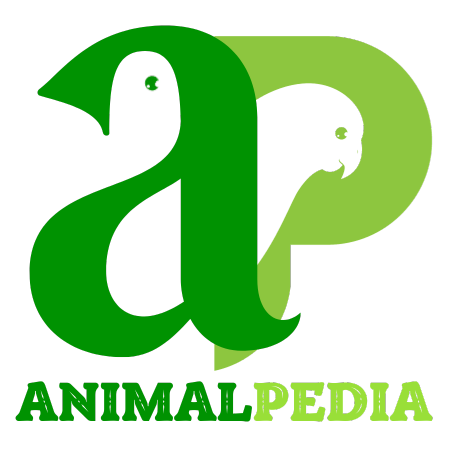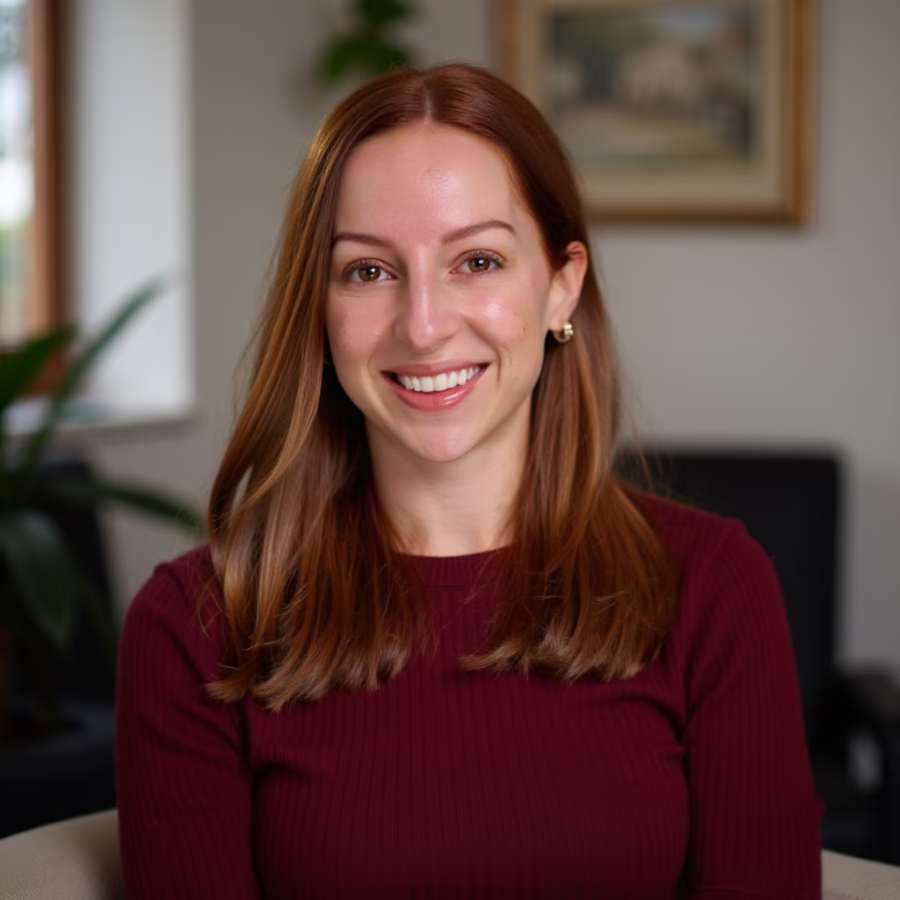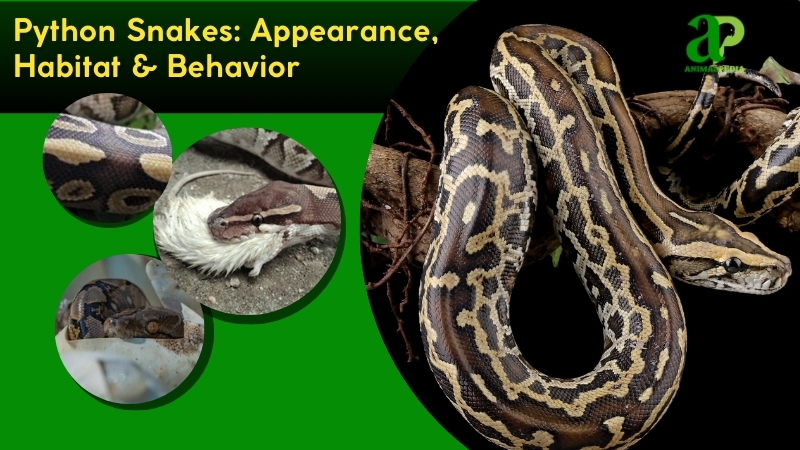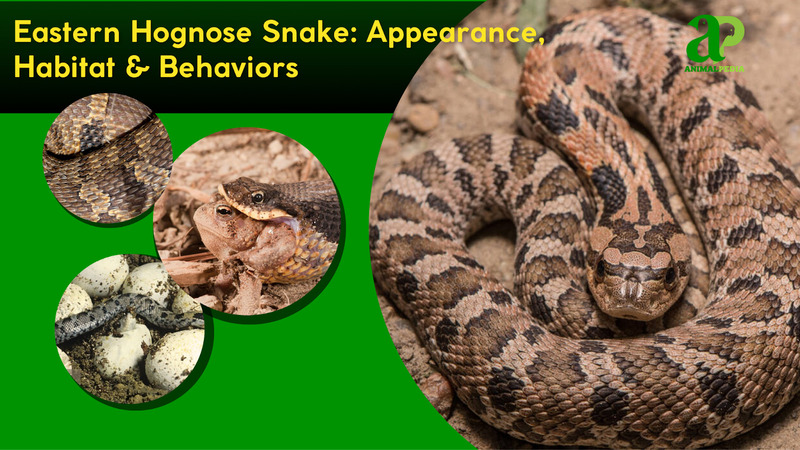Coachwhip snakes (Masticophis flagellum) command attention with their striking appearance. Seven distinct species comprise the Masticophis genus, each exemplifying serpentine evolution. Their sleek, elongated bodies stand out across their range’s diverse ecosystems.
The most notable populations inhabit regions from the southeastern United States to northern Mexico, with significant presence on Padre Island, Texas. Their most impressive characteristic? Length—typically reaching up to 8 feet (2.4 meters), with exceptional specimens growing to 9 feet (2.7 meters).
Speed defines these reptiles. Though not apex predators, they excel as pursuit hunters, capturing lizards, small mammals, birds, and insects with agility. Their dietary flexibility adapts to prey availability, demonstrating ecological adaptability rather than specialization. Coachwhips employ rapid strikes, briefly coiling to immobilize prey without true constriction. Humans encounter their defensive hiss and tail vibration, though their bites—infrequent and non-venomous—pose minimal risk.
Their reproductive cycle follows consistent patterns. Mating occurs in spring, typically April through June. Females deposit 4-20 eggs in summer, preferring sandy burrows or leaf litter as nesting sites. Incubation lasts 6-11 weeks. Hatchlings emerge at 12-16 inches (30-40 cm), hunting independently from birth. Sexual maturity arrives in 2-3 years, with natural lifespans extending 10-15 years in suitable habitats.
This article examines Coachwhip snakes—their morphology, habitat preferences, and behavioral patterns. Animal-pedia.org presents these fascinating reptiles with scientific accuracy and visual clarity, creating content valuable for both enthusiasts and researchers studying Colubridae family serpents.
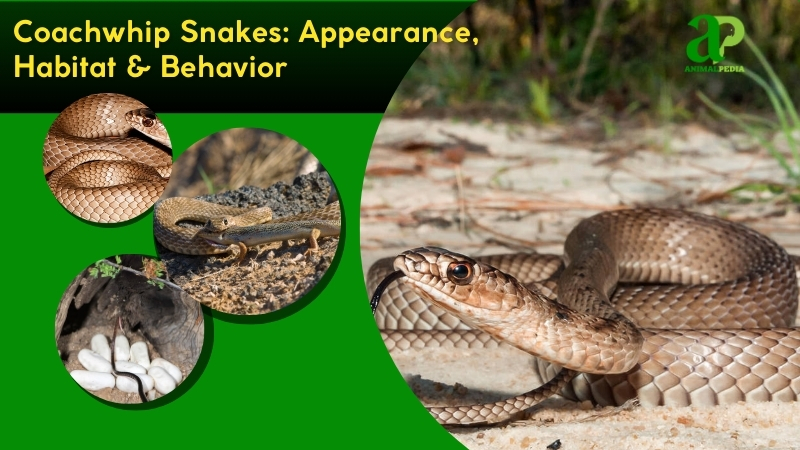
Before going into the characteristics of each group, you can skim through the classification of snakes (full guide).
What Do The Coachwhip Snakes Look Like?
Coachwhip snakes boast a sleek, elongated body that resembles a slender whip. Their general shape stretches thin and cylindrical, tapering smoothly from head to tail. The overall color shifts from dark brown or black at the head to a lighter tan or reddish hue toward the tail, mimicking a braided whip—hence the name.
Patterns vary, but many sport subtle, gradient-like transitions rather than bold markings. Their skin, covered in smooth, glossy scales, feels dry and polished, aiding their swift movements through scrublands and grasslands.
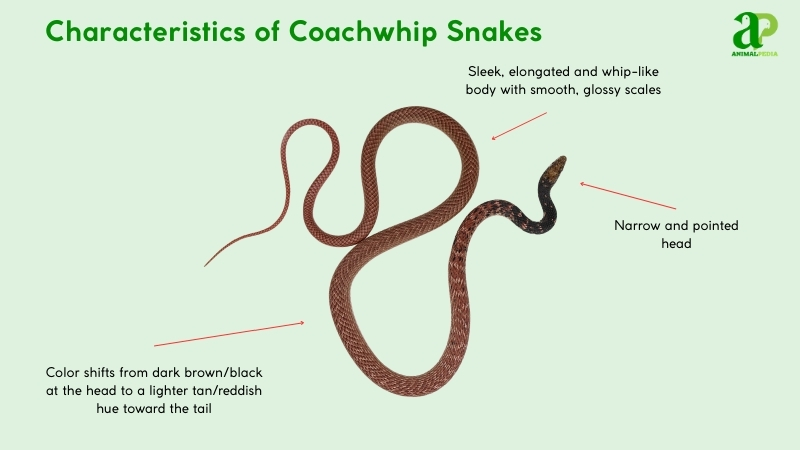
From head to tail, distinct features emerge. The head, narrow and pointed, houses large, keen eyes with round pupils, sharp for spotting prey. A forked tongue flicks out, sampling the air. The neck blends seamlessly into a lithe, muscular body, devoid of limbs or claws—pure serpentine elegance. The tail, long and thin, accounts for nearly half their total length, often 4-5 feet (1.2-1.5 meters) of the 8 feet (2.4 meters).
Compared to similar racers like the Coluber constrictor, coachwhips stand out with their whip-like taper and color gradient. While Coluber often remains uniformly dark, Masticophis flagellum exhibits a striking two-tone shift, a hallmark of the species.
Differences in characteristics of Coachwhip vs Garter Snakes?
How Big Do Coachwhip Snakes Get?
Coachwhip snakes average 4-6 feet (1.2-1.8 meters) in length and weigh about 1-2 pounds (0.45-0.9 kg). These lithe serpents, found across North America, keep a slender build. Adults typically reach 6 feet (1.8 meters) from snout to tail, though size varies by region and diet.
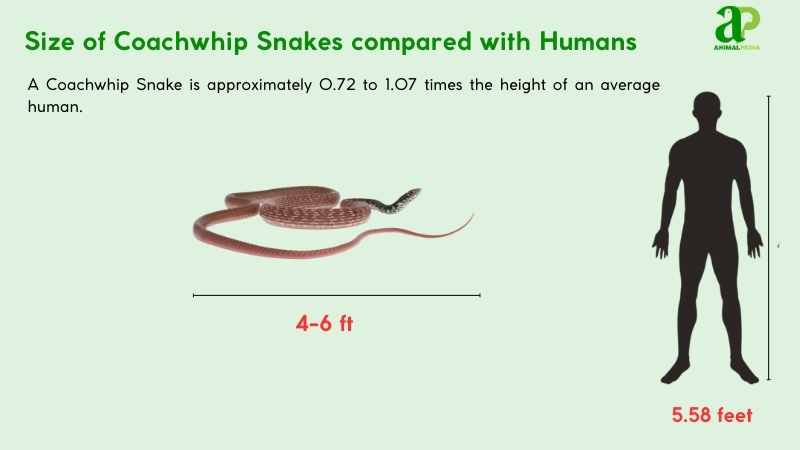
The longest recorded coachwhip, discovered in Texas, stretched 9 feet (2.7 meters), according to a 2016 study by Gibbons and Dorcas.
No definitive heaviest specimen exists, but weights rarely exceed 2.5 pounds (1.1 kg). Males and females differ slightly—males grow longer, averaging 6-7 feet (1.8-2.1 meters), while females top out at 5-6 feet (1.5-1.8 meters) and weigh a touch more. See the table below for details.
| Trait | Male | Female |
| Length | 6-7 ft (1.8–2.1 m) | 5-6 ft (1.5–1.8 m) |
| Weight | 1–2 lbs (0.45–0.9 kg) | 1.5–2.5 lbs (0.7–1.1 kg) |
What Are The Unique Physical Characteristics Of The Coachwhip Snakes?
Coachwhip snakes feature a whip-like physique and a distinct color pattern. Their slender, elongated body mimics a braided whip, narrowing dramatically from head to tail. This streamlined shape combines with dual-tone coloration—dark anterior gradually lightening to tan or reddish posterior—distinguishing them from single-colored racers like Coluber constrictor. Their glossy scales boost mobility, a feature less evident in bulkier serpent species.
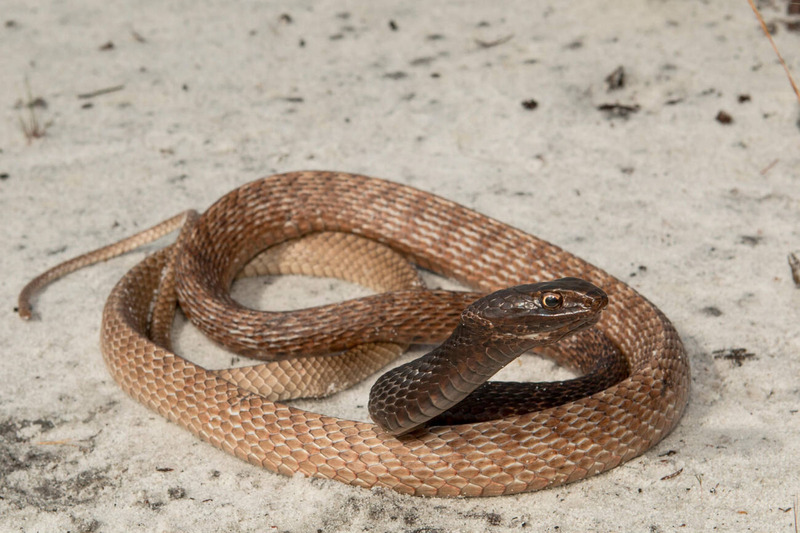
How Do Coachwhip Snakes Adapt With Their Unique Features?
Coachwhip snakes dominate their ecosystems through evolutionary adaptations centered on their whip-like physiology. Their slender, tapered bodies cut through dense vegetation and pursue prey across open terrain at high speed. The smooth scale structure reduces friction, enhancing maneuverability across diverse habitats ranging from Texas chaparral to arid Mexican desert ecosystems.
Their sensory apparatus complements this morphological advantage. Prominent ocular structures detect movement at significant distances, maximizing predatory efficiency. Their bifurcated tongue collects environmental chemosensory data, precisely locating food sources or potential threats. Specialized mechanoreceptors throughout their integumentary system detect substrate vibrations, providing crucial early warning against predators. These integrated adaptive traits, documented by herpetologists Gibbons and Dorcas (2016), create a substantial competitive advantage in their ecological niche.
Anatomy
Coachwhip snakes are among North America’s most agile classification of reptiles, thriving in dry grasslands, open forests, and deserts. Their physiology reflects evolutionary refinements for speed, endurance, and precision in predation. To understand their ecological success, we must examine the internal systems that power their lives.
- Respiratory System: Paired lungs, with the right lung elongated, are efficiently oxygenated during rapid pursuits. Air flows via a glottis, optimizing stamina (Hammerson, 2019).
- Circulatory System: A three-chambered heart pumps blood swiftly, delivering oxygen to muscles. Efficient circulation sustains their high-speed chases across scrublands.
- Digestive System: A long, flexible esophagus and stomach process prey whole—lizards, birds, insects. Strong acids break down meals quickly, providing energy.
- Excretory System: Kidneys filter waste into uric acid, conserving water in arid environments. This adaptation suits their dry, terrestrial range.
- Nervous System: A keen brain and spinal cord drive sharp reflexes. Large optic nerves link to alert eyes, enhancing prey detection.
From respiration to neural acuity, each anatomical system in the coachwhip snake reflects specialized adaptation. Together, they create a streamlined predator built for speed, resilience, and survival in some of the continent’s toughest terrains.
Where Do Coachwhip Snakes Live?
Coachwhip snakes inhabit a broad range across North America, stretching from the southeastern United States to northern Mexico. They thrive mainly in Texas, Arizona, and New Mexico, with significant populations on Padre Island and throughout the Chihuahuan Desert. These regions provide extensive scrublands and grasslands, which are essential to their survival.
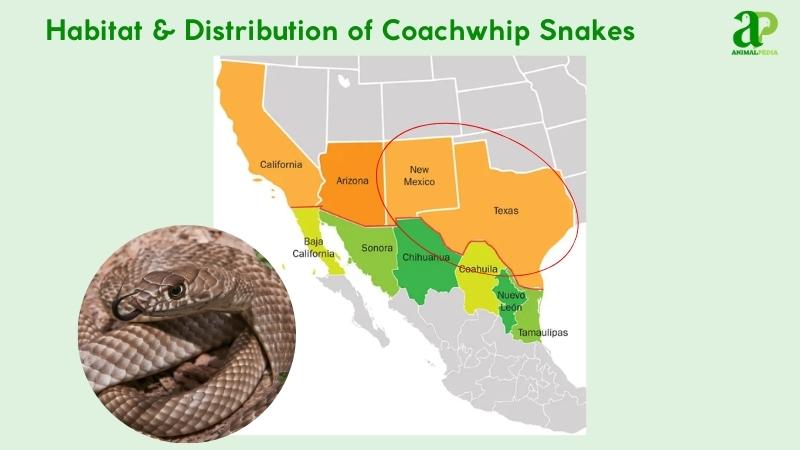
Their preferred habitat features dry, open terrain with sandy soils and minimal vegetation—perfect conditions for their speed and hunting efficiency. The warm climate accommodates their ectothermic physiology, while the sparse ground cover enables effective prey pursuit. According to Gibbons and Dorcas (2016), this environment perfectly complements their whip-like agility and hunting techniques.
Fossil evidence indicates that coachwhips have occupied these arid regions for thousands of years, with little geographic change. Their distribution is stable, as reported by the IUCN (2017), reflecting their specialized adaptation to desert ecosystems rather than seasonal migration. This geographic consistency underscores their evolutionary success in harsh environments.
How Do Seasonal Changes Affect Their Behavior?
Coachwhip snakes adjust their behavior across four seasonal shifts in response to temperature, prey availability, and daylight.
- Spring (March–May): Active emergence from brumation. Males begin territorial movement, and mating behavior peaks.
- Summer (June–August): Activity reaches its height. Diurnal hunting increases. Snakes seek shaded habitats to avoid overheating.
- Autumn (September–November): Feeding slows. Coachwhips reduce movement and prepare for brumation by locating sheltered sites.
- Winter (December–February): Enter brumation—a torpor-like dormancy. Activity is nearly absent, conserving energy during cold months.
Coachwhips exhibit marked seasonal plasticity, optimizing survival in arid and temperate ecosystems. These shifts, noted by Gibbons and Dorcas (2016), align with their ectothermic nature and prey availability.
What Is The Behavior Of Coachwhip Snakes?
Coachwhip snakes are agile, highly alert colubrids that thrive across arid, open terrain in North America. Their behavior reflects evolutionary fine-tuning for speed, stealth, and survival in harsh environments.
- Feeding Habits: They hunt lizards, birds, and insects, striking fast without constriction. Diet adapts to prey availability.
- Bite & Venomous: Bites are rare, defensive, and harmless—no venom exists. Tail-vibrating mimics rattlesnakes.
- Daily Routines: Diurnal; they bask in the mornings, then roam widely. Activity peaks in warm months.
- Locomotion: Speed defines them, slithering up to 8 mph (13 kph). Whip-like bodies aid agility.
- Social Structures: Solitary, they meet only to mate. Territories overlap without conflict.
- Communication: Hissing and tail rattles signal defense. No vocalization occurs.
These behavioral traits—rooted in ecological necessity—allow coachwhips to exploit diverse niches while minimizing risk. Their responsiveness to environmental cues underscores their evolutionary success as adaptive surface predators.
What Do Coachwhip Snakes Eat?
Coachwhip snakes (Masticophis flagellum) are opportunistic carnivores. Their diet includes lizards, small mammals, birds, frogs, and insects—whatever they can overpower. They favor fast-moving prey and are known for visual hunting.

- Diet by Age
Juvenile coachwhips mainly consume insects and small lizards. These prey types are easy for smaller snakes to catch and digest. As coachwhips mature, their diet broadens to include birds, rodents, frogs, and even other snakes. Their speed and jaw flexibility allow them to capture and swallow larger prey whole, typically without subduing them.
- Diet by Gender
Males and females share the same prey spectrum. However, during the mating season, males often exhibit increased foraging activity to meet higher energy needs. No significant differences in prey types are observed between the sexes.
- Diet by Seasons
In spring and summer, when prey like birds, reptiles, and insects are abundant, coachwhips hunt more frequently. During colder months or droughts, their feeding decreases as prey becomes less active and harder to find (Hammerson, 2019).
How Do Coachwhip Snakes Hunt Their Prey?
Coachwhip snakes excel as hunters, using speed and agility to capture prey. These colubrids possess keen vision to detect targets before executing swift strikes. Their diet consists primarily of rodents, birds, lizards, and other small vertebrates, making them vital mesopredators within their ecological niches.
Their hunting strategy combines stealth and precision. Masticophis flagellum (the scientific name for coachwhips) tracks prey with minimal movement, demonstrating exceptional locomotor efficiency until the optimal moment to attack arrives.

With burst speeds reaching 8-10 mph, these diurnal hunters launch lightning-fast attacks, often overtaking prey before escape becomes possible. This ambush-pursuit hybrid technique proves highly effective in the arid habitats they dominate.
The predatory behavior of coachwhips represents a textbook example of evolutionary adaptation in reptiles. Their visual acuity and muscular coordination showcase the refined hunting adaptations that have evolved through natural selection.
Are Coachwhip Snakes Venomous?
Coachwhip Snakes aren’t venomous, relying instead on their speed and agility to hunt their prey effectively. These snakes, known for their lightning-fast movements, use their exceptional eyesight and sense of smell to track down fast-moving targets such as lizards, rodents, and birds.
With their impressive hunting skills, Coachwhip Snakes demonstrate their prowess as formidable predators in various terrains.
Their ability to swiftly chase down prey, combined with their agility in climbing and swimming, showcases the versatility of Coachwhip Snakes as hunters.
Despite lacking venom, these snakes use their strong bodies and keen senses to capture their next meal successfully. So, while they may not possess the potent neurotoxins of a Tiger Snake, the Coachwhip’s mastery of speed makes it an equally formidable predator
When Are Coachwhip Snakes Most Active During The Day?
Coachwhip Snakes are most active during the day, especially in the early morning and late afternoon. They prefer warmer temperatures and enjoy basking in the sun to warm up before moving around. These snakes are at their peak energy levels when the day is starting or winding down.
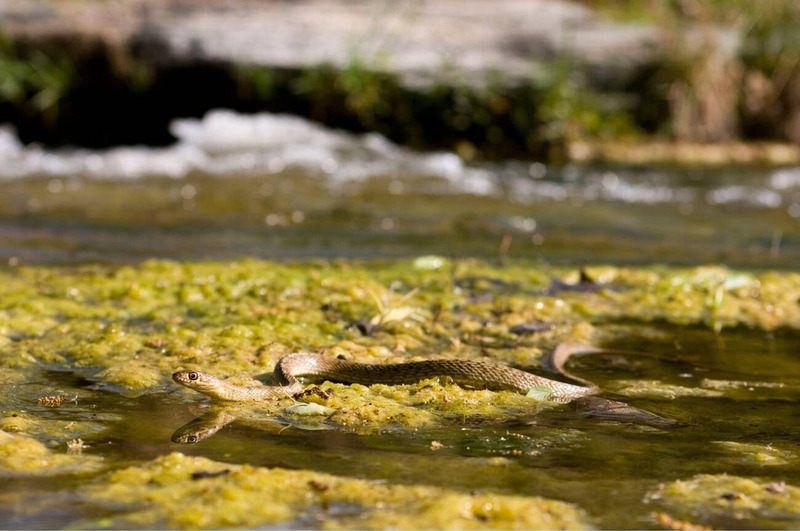
As the sun rises, Coachwhip Snakes come out to explore and hunt for food, such as rodents and birds. With their keen senses, they easily navigate their surroundings during daylight hours.
These sleek and speedy serpents use the daylight to their advantage, moving with precision and agility as they go about their activities.
How Do Coachwhip Snakes Move On Land And Water?
Coachwhip Snakes move quickly and agilely across land. Their long bodies and smooth scales reduce friction, allowing them to glide effortlessly over various terrains. When hunting prey, these terrestrial reptiles can reach impressive speeds, sometimes up to 8-10 mph. Their muscular locomotion makes them among the fastest snakes in North America.

Though primarily land-dwellers, Coachwhips demonstrate surprising adaptability in water. When encountering aquatic obstacles, they employ lateral undulation to propel themselves forward. Their slender physique enables efficient swimming mechanics, though they don’t seek out water habitually. Unlike corn snakes, these colubrids (family Colubridae ) maintain their characteristic agility even when navigating streams or ponds.
The biomechanics of Coachwhip movement showcase their evolutionary adaptation to their native habitats. Whether racing across arid landscapes or traversing occasional water barriers, these snakes exhibit locomotor efficiency that perfectly suits their active hunting strategy and predatory lifestyle.
This behavior is a sharp contrast to the Water Moccasin Snake, which is built to actively hunt in the water.
Do Coachwhip Snakes Live Alone Or In Groups?
Coachwhip Snakes are typically solitary creatures, preferring to live independently without the companionship of others. These snakes are known for their self-reliance and tendency to explore their environments independently. They hunt for prey and navigate their surroundings without the need for social interaction.
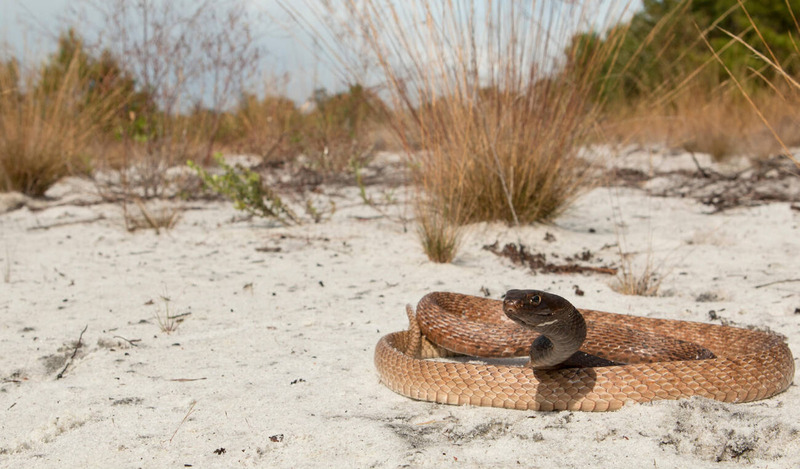
While Coachwhip Snakes may briefly come together during the mating season, they generally lead solitary lives. This independent behavior allows them to make quick decisions and adapt easily to changes in their surroundings, without the constraints of group dynamics. By living alone, Coachwhip Snakes reduce competition for resources, enabling each snake to thrive on its own terms.
Understanding the key squamata characteristics will give you insight into the unique features that define this diverse reptile group
How Do Coachwhip Snakes Communicate With Each Other?
Coachwhip Snakes communicate without words. They use clear visual signals, such as head-raising when threatened or body-flattening, to warn rivals. Their forked tongues collect chemical cues from the environment, helping them track other snakes’ pheromones through chemoreception.
Physical contact forms another communication channel. These serpents engage in direct tactile interactions—touching, rubbing, and intertwining their bodies during courtship displays. Male coachwhips perform specific combat rituals when competing for females, raising their anterior portions in dominance contests without causing serious injury.
The Masticophis flagellum species relies on this sophisticated non-verbal system across its range from the southern United States to central Mexico. Their communication behaviors differ significantly between breeding and non-breeding seasons, with seasonal pheromone production peaking during spring mating. This multi-modal approach to interaction demonstrates the evolutionary adaptations these slender, fast-moving reptiles have developed for survival in open grassland and desert scrub habitats.
How Do Coachwhip Snakes Reproduce?
Coachwhip snakes (Masticophis flagellum) reproduce through oviparity, laying eggs rather than birthing live young. This reproductive strategy suits their terrestrial lifestyle in arid regions of North America.
Breeding season begins in spring, from April through June. Male coachwhips actively track females using chemosensory cues. Courtship involves tail vibrations and body intertwining. Females signal reproductive readiness through pheromone release. Mating requires cloacal alignment and may last from minutes to several hours, as documented by herpetologists Gibbons and Dorcas (2016).
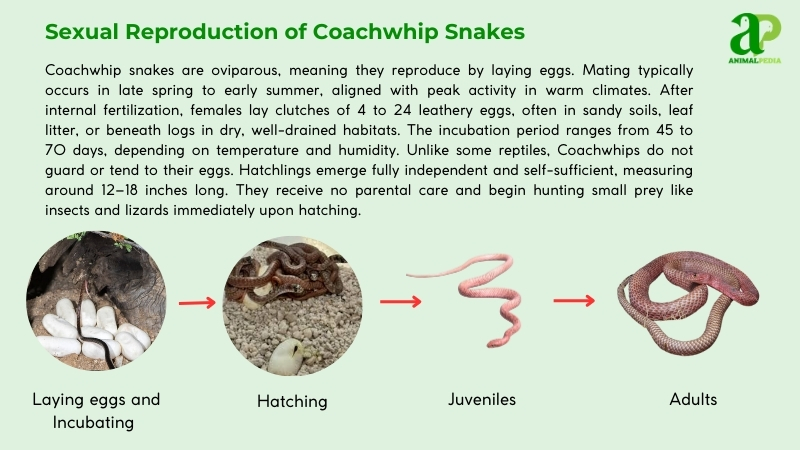
After successful copulation, females deposit clutches of 4-20 eggs by July. Each egg weighs approximately 2-3 grams (0.07-0.1 oz). Females select oviposition sites in sandy burrows or dense leaf litter—locations providing natural temperature regulation. Neither parent provides parental care after egg deposition. Environmental stressors, such as drought, can significantly impact reproduction, as observed during the severe 2018 drought (IUCN, 2017).
The incubation period ranges from 6 to 11 weeks, and the development rate is primarily influenced by ambient temperature. Hatchlings emerge measuring 12-16 inches (30-40 cm) and are immediately self-sufficient, able to capture small prey. Juvenile coachwhips experience rapid growth, achieving sexual maturity within 2-3 years.
The average lifespan of coachwhip snakes spans 10-15 years in suitable habitats. Clutch size variation correlates with female health status and environmental conditions, whereas long-term population viability depends on habitat stability and resource availability.
How Long Do Coachwhip Snakes Live?
Coachwhip snakes (Masticophis flagellum) live 10-15 years in the wild. They reach sexual maturity at 2-3 years, with survival depending on habitat quality, predation, and environmental factors, according to Gibbons and Dorcas (2016). In protected captive environments, these reptiles may live longer than their wild counterparts by avoiding natural threats.
Their average lifespan is about 12 years. Both sexes exhibit equal longevity patterns under optimal conditions, as IUCN (2017) research confirms. Neither males nor females display significant survival advantages in their natural range.
Wild coachwhips rarely reach their maximum potential age. They face numerous threats, including habitat destruction, road mortality, and natural predation by raptors and medium-sized mammals (Ernst & Ernst, 2019). Juvenile mortality runs higher than adult deaths. Survivors thrive in xeric habitats with ample sunlight and open terrain—perfect for these fast-moving, diurnal hunters.
What Are The Threats Or Predators That Coachwhip Snakes Face Today?
Coachwhip snakes confront multiple threats and predators in their North American range. Habitat loss, road mortality, and climate shifts top the list, while natural foes prey on them.
- Habitat Loss: Urban sprawl and agriculture shrink scrublands, slashing territory. Population fragment, per IUCN (2017).
- Road Mortality: Vehicles kill many, especially in Texas and Arizona. High traffic zones cut survival rates.
- Climate Change: Droughts alter prey availability and breeding. Warmer winters disrupt brumation cycles.
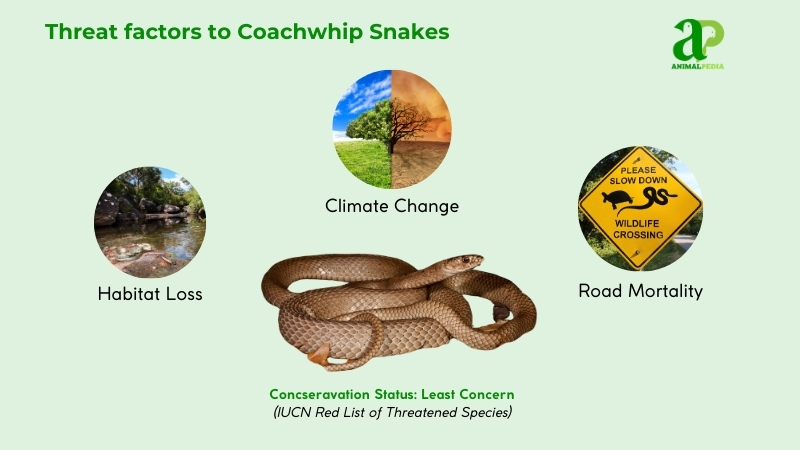
Predators include hawks, owls, and larger snakes, such as kingsnakes (Lampropeltis getula). These raptors and reptiles target coachwhips, especially juveniles, exploiting their exposed habitats. Hatchlings, at 12-16 inches (30-40 cm), face a higher risk of predation.
Humans amplify these woes. Development razes habitats, and cars claim lives—Gibbons and Dorcas (2016) note roadkill spikes near highways. Pesticides indirectly trim prey, while myth-driven killings persist, despite their non-venomous nature. Still, their Least Concern status (IUCN, 2017) reflects resilience, though vigilance is key.
Are Coachwhip Snakes Endangered?
Coachwhip snakes (Masticophis flagellum) are not endangered. These fast-moving reptiles maintain stable populations across their North American range.
The International Union for Conservation of Nature (IUCN) has listed coachwhips as Least Concern since 2017. This classification indicates minimal extinction risk due to their widespread distribution and environmental adaptability. Coachwhips flourish in diverse ecosystems—from Texas scrublands to Mexican deserts—demonstrating resilience in the face of habitat changes.
Population metrics are limited, as these colubrids aren’t subject to intensive monitoring programs. Herpetologists Gibbons and Dorcas (2016) documented densities of 1-2 specimens per hectare in prime habitats such as Arizona grasslands. The IUCN assessment (2017) confirms that there has been no substantial decline, with field observations suggesting consistent numbers throughout the southeastern United States and northern Mexico. Their success stems from versatile hunting strategies and their tolerance for varied terrain.
What Conservation Efforts Are Underway?
Coachwhip snakes enjoy protection through focused conservation initiatives despite their Least Concern status (IUCN, 2017). Key wildlife agencies, including the U.S. Fish and Wildlife Service and state departments, have prioritized habitat conservation programs that have been running since the early 2000s to combat habitat fragmentation and vehicle-related deaths.
Legal frameworks strengthen their protection. While not specifically listed under the Endangered Species Act of 1973, coachwhips benefit indirectly when the law protects their ecosystems by safeguarding companion species such as the gopher tortoise. Current regulations ban habitat destruction and excessive pesticide use across critical ranges in the Southwest—particularly Texas, Arizona, and New Mexico—and are enforced at multiple levels of government.
Captive breeding programs are limited for coachwhips due to their relatively stable populations, but parallel conservation models show promise. The Orianne Society’s work with eastern indigo snakes demonstrates effective reptile conservation through captive propagation and habitat restoration, having released more than 300 snakes since 2010, with a 60% survival rate (Elmore, 2023). Coachwhips benefit from these ecosystem-based approaches. Research by Gibbons and Dorcas (2016) documents population recovery in a Texas coachwhip community following scrubland restoration—a success story connected to broader reptile preservation strategies.
Frequently Asked Questions
Do Coachwhip Snakes Make Good Pets?
Not recommended. They’re best left in the wild due to their natural behaviors and specific needs. Consider a pet that’s better suited as a low-maintenance companion. Your choice impacts their well-being.
How Do Coachwhip Snakes Defend Themselves?
When threatened, coachwhip snakes opt for a swift retreat, using their incredible speed and agility to escape predators. They may also puff up their bodies and hiss loudly to intimidate potential threats and avoid confrontation.
What Do Coachwhip Snakes Eat In The Wild?
In the wild, coachwhip snakes eat a variety of prey like rodents, lizards, birds, and even other snakes. They are skilled hunters, using their speed and agility to catch their meals in the desert ecosystem.
Can Coachwhip Snakes Be Harmful To Humans?
Yes, coachwhip snakes can be harmful to humans if provoked or threatened. Their bite is not venomous, but it can be painful. Remember to give these snakes space and respect their territory to stay safe.
Are Coachwhip Snakes Endangered Species?
You’ll be glad to know that Coachwhip Snakes are not endangered. Their population is stable, and they play a crucial role in their ecosystems. Feel at ease knowing they are thriving!
Conclusion
Coachwhip snakes (Masticophis flagellum) stand out among reptiles for their distinctive slender morphology, adaptability across diverse habitats, and specialized predatory tactics. Their exceptional speed and agility make them formidable hunters in various ecosystems, from deserts to grasslands. Ranging in coloration from reddish-brown to black, and growing to impressive lengths of 4-8 feet, these colubrids epitomize the evolutionary success of non-venomous constrictors.
These diurnal reptiles serve as critical mesopredators within their native ranges, helping regulate populations of rodents, lizards, and smaller snakes. Their presence maintains ecological balance throughout the southern and southwestern United States. As we continue to study these ophidians, we gain a deeper appreciation for their ecological significance and behavioral complexity.
Conservation of these magnificent Masticophis species and their environments is paramount. By respecting their territory and natural behaviors, we ensure future generations will witness these extraordinary serpents in their natural settings.
